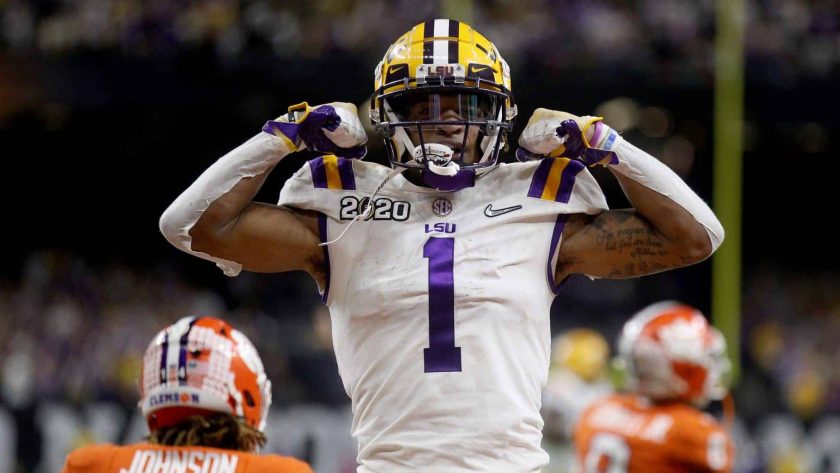New York Jets: 5 WRs to target in the 2021 NFL Draft

The New York Jets’ wide receiver situation is a mess, to say the least. A loaded 2021 NFL Draft could provide a long-term solution.
[sc name=”kyle-newman-banner” ]The 2020 season hasn’t even started, but it’s clear the New York Jets have a long-term issue at wide receiver. Even if 2020 second-round pick Denzel Mims lives up to his lofty expectations, the Jets are still in trouble. Breshad Perriman‘s contract is up at the end of the year and Jamison Crowder could be a cap casualty in 2021.
Even if both are brought back, neither has the potential to be a No. 1 receiver. The Jets have one of the weakest receiving corps in the NFL for the present and the future. Luckily for them, the 2021 class is even more stacked at the position than the 2020 class.
As many as four receivers have the potential to be top-10 picks. However, many of them have already opted out of the 2020 college season. Scouts will have to base their decisions on past tape and the predraft process to come.
With that in mind, here are five wide receivers who could make sense for the Jets in the 2021 NFL draft.
Ja’Marr Chase, LSU
Ja’Marr Chase is the clear cut No. 1 receiver in the 2021 NFL Draft. He’s been called the best wide receiver prospect since Julio Jones.
What makes Chase great isn’t his size or his athleticism, it’s his technical prowess combined with his physicality. That isn’t to say that Chase is smaller or lacks athleticism. He stands at 6-foot and 207 pounds, more than big enough to play outside in the NFL. Chase is expected to run a 4.40 forty-yard dash at the NFL Scouting Combine, which would have been seventh fastest at the 2020 combine.
Where Chase truly shines is his elite strength and physicality. They allow him to dominate contested catches, separate on deep routes, and break tackles. Chase is never going to be a speed burner who runs past defense or makes special plays underneath. Where he’s going to excel is with his elite hands and his elite play strength.
His route running isn’t bad, but it’s still raw. That’s to be expected when Chase has only started one season in his college career. That’s how it’s going to stay as Chase has opted out of the 2020 season.
The best modern-day comparison for Chase is Detroit Lions star Kenny Golladay. A receiver who bullies cornerbacks to get whatever he wants on the field. Golladay is a legitimate No. 1 but lacks the athleticism to be truly elite in the NFL.
Chase’s extra speed gives him a higher ceiling than Golladay’s, but even if he never hits that next tier Chase should be a legitimate No. 1 receiver.
Rondale Moore, Purdue
No receiver in the 2021 NFL Draft has a higher ceiling than Rondale Moore. The little sparkplug is more than just the next Tyreek Hill, as some have called him. His athleticism, technique, and understanding of the game are at an entirely different level.
However, he does come with his own set of concerns. His hands haven’t been the greatest, he’s incredibly small at just 5-foot-9 181 pounds, and he has an injury history.
Moore showed his potential right from the opening kickoff at Purdue. In his first game as a true freshman, Moore set the Purdue single-game all-purpose yards record.
He finished the season with 1,258 receiving yards and another 231 on the ground. He looked ready to eclipse those numbers as a sophomore in 2019, but a knee injury ended his season after just four games.
To say Moore is going to light up the combine would be an understatement. The Purdue product ran a 4.33 40-yard dash as a high school student. It’s very possible that he could challenge John Ross’ NFL combine record.
That’s just the start, Moore is explosive in every way as an athlete. His jumping ability, his speed, and even his strength.
Moore isn’t as strong as Chase, but he has more than enough strength to play outside and take on any defender who tries to bully him.
The best way to describe Moore as a player is if Tyreek Hill and Steve Smith Sr. fused into one player. That is if he can manage to stay healthy.
He would have had the chance to prove that this season, but he also chose to opt-out of the 2020 season. Unlike the others on this list, most of Moore’s tape is dated back two years. It’s going to be incredibly difficult for scouts to properly evaluate him.
That said, Moore is a near-lock to be a first-round pick come April 2021.
Jaylen Waddle, Alabama
Jaylen Waddle is similar in a lot of ways to his former Alabama teammate Henry Ruggs III. Speed is the name of the game and his hands are excellent
What separates Waddle is his ability as a more complete receiver. He can win contested catches, he has better play strength, and his catch radius is wider. That’s why Waddle is a potential top-10 pick when Ruggs wasn’t.
However, Waddle has a pretty big wart on his resume—his route running. Waddle hasn’t run a large route tree at Alabama, mostly because of who’s been in front of him on the depth chart. When asked to expand his route tree he’s struggled immensely, especially with intermediate routes.
Waddle plays at one speed, full speed. That’s great when he’s asked to take screens for big gains or beat a corner deep, but it limits the routes he can take. He struggles with quick-twitch routes because his speed forces his momentum one way forcing him to round off routes rather than make sharp turns.
Waddle has a chance to show the world he’s improved on this weakness though, he’s currently set to be Alabama’s No. 2 wide receiver for 2020. He has the opportunity to make an impression on the minds of scouts that Chase and Moore don’t.
DeVonta Smith, Alabama
DeVonta Smith could have come out in 2020 and likely would have been a late first-round or early second-round pick. Instead, he chose to return to Alabama for his senior year, where he’ll be the team’s No. 1 receiver.
Smith is known for his excellent route running and hands. He’s polished well beyond his years and that makes him the safest player on this list. That said, his lack of strength and contested-catch ability limits his ceiling.
Smith’s route running has helped him dominate the NCAA, but when he doesn’t create immediate separation he struggles mightily. He lacks the strength to beat physical corners and the athleticism to beat athletic ones. If he isn’t winning with his technique, he can disappear.
Smith is a lot like former Alabama wide receiver Amari Cooper. He could be a No. 1 receiver in the NFL if all works out, but even if it doesn’t, he’ll likely carve out some role for himself in a starting offense.
Rashod Bateman, Minnesota
Rashod Bateman is to the 2021 class what CeeDee Lamb was to the 2020 class—a big-bodied receiver with excellent hands and surprising ability after the catch.
There isn’t a catch Bateman can’t make. He can make the sideline catch, he can make a contested catch, and he has the concentration to make all the simple catches.
His route running is good, not great, and he’s not all that athletic. He relies on his strength and hands to do most of the work. That should carry over to the NFL.
His biggest weaknesses, like Lamb, are his athleticism and separation. Cornerbacks aren’t going to be as easy to bully at the NFL level. If he doesn’t improve, it’s going to be hard for him to make his presence felt against the elite corners in the league.
Bateman likely isn’t going to become a superstar, though DeAndre Hopkins has proven it’s possible for this archetype to become one, but he should carve out a role as a No. 1 or 2 at the next level.
BET $5 & GET $150 IN BONUS BETS INSTANTLY! BET $5, GET $150 BONUS! $1,000 BET ON CAESARS! BET $5, GET $158 BONUS! GET $150 BONUS OR $2,000 FIRST-BET SAFETY NET!
A contributor here at elitesportsny.com. I'm a former graduate student at Loyola University Chicago here I earned my MA in History. I'm an avid Mets, Jets, Knicks, and Rangers fan. I am also a prodigious prospect nerd and do in-depth statistical analysis.











